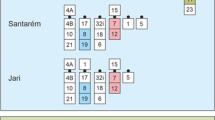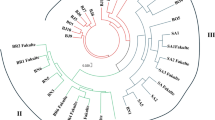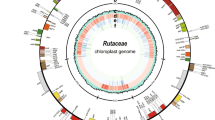Abstract
In introgressive hybridization (the repeated backcrossing of hybrids with parental populations), Edgar Anderson found a source for variation upon which natural selection could work. In his 1953 review article “Introgressive Hybridization,” he asserted that he was “bringing taxonomy to the service of genetics” whereas distinguished colleagues such as Theodosius Dobzhansky and Ernst Mayr did the precise opposite. His work as a geneticist particularly focused on linkage and recombination and was enriched by collaborations with Missouri Botanical Garden colleagues interested in taxonomy as well as with cytologists C.D. Darlington and Karl Sax. As the culmination of a biosystemtatic research program, Anderson’s views challenged the mainstream of the Evolutionary Synthesis.
Similar content being viewed by others
References
Allen, Garland. 1975. Life Sciences in the Twentieth Century. New York: Wiley.
Anderson, Edgar. 1924. “Studies on Self-Sterility VI. The Genetic Basis of Cross-Sterility in Nicotiana.” Genetics 9: 13–39.
Anderson, Edgar. 1928. “The Problem of Species in the Northern Blue Flags, Iris versicolor L. and Iris virginica L.” Annals of the Missouri Botanical Garden 15: 241–332.
Anderson, Edgar. 1939a. “The Hindrance to Gene Recombination Imposed by Linkage: An Estimate of Its Total Magnitude.” The American Naturalist 73: 185–188.
Anderson, Edgar. 1939b. “Recombination in Species Crosses.” Genetics 24: 668–698.
Anderson, Edgar. 1940. “Edward Murray East (1879–1938).” Proceedings of the American Academy of Arts 74: 117–118.
Anderson, Edgar. 1948. “Hybridization of the Habitat.” Evolution 2: 1–9.
Anderson, Edgar. 1949. Introgressive Hybridization. New York: Wiley.
Anderson, Edgar. 1952. Plants, Man and Life. Boston: Little, Brown, and Company.
Anderson, Edgar. 1953. “Introgressive Hybridization.” Biological Review (Cambridge) 28: 280–307.
Anderson, Edgar. 1962. “The Role of Hybridization in Evolution.” Willis H Johnson, William C Steere (eds.), This is Life: Essays in Modern Biology. New York:Holt, Rinehart, and Winston, pp. 287–314.
Anderson, Edgar. 1967. The Importance of My Work to Corn Breeding. Archives of the Missouri Botanical Garden:Typescript in Anderson Papers.
Anderson, Edgar. 1968. “What We Do Not Know About Zea Mays.” Transactions of the Kansas Academy of Science 71: 373–378.
Anderson, Edgar, Hubricht, Leslie. 1938. “Hybridization in Tradescantia III. The Evidence for Introgressive Hybridization.” American Journal of Botany 25: 396–402.
Anderson, Edgar, Woodson, Robert. 1935. “The Species of Tradescantia Indigenous to the United States.” Contributions of the Arnold Arboretum 9: 1–132.
Arnold, Michael L. 1997. Natural Hybridization and Evolution. New York: Oxford University Press.
Baker, HG. 1951. “Hybridization and Natural Gene-Flow Between Higher Plants.” Biological Review (Cambridge) 26: 302–337.
Darlington, CD. 1932. Recent Advances in Cytology.London: Churchill..
Dobzhansky, Theodosius. 1937. Genetics and the Origins of Species. New York: Columbia University Press.
Epling, Carl C. 1947. “Natural Hybridization of Salvia apianna and Salvia mellifera.” Evolution 1: 69–78.
Farrington, Heather L, Lawson, LP, Clark, CM, Petren, K. 2014. “The Evolutionary History of Darwin’s Finches: Speciation, Gene Flow, and Introgression in a Fragmented Landscape.” Evolution 68–10: 2932–2944.
Hagen, Joel B. 1984. “Experimentalists and Naturalists in Twentieth Century Botany: Experimental Taxonomy, 1920–1950.” Journal of the History of Biology 17: 249–270.
Harman, Oren. 2004. The Man Who Invented Chromosomes: A Life of Cyril Darlington. Cambridge: Harvard University Press.
Harman, Oren. 2008. “In Weismann’s Footsteps: The Cyto-Rebellion of Cyril Darlington.” O Harman, MR Dietrich (eds.), Rebels, Mavericks, and Heretics in Biology. New Haven: Yale University Press, pp. 103–118.
Kleinman, Kim. 1999. “‘His Own Synthesis: Corn, Edgar Anderson, and Evolutionary Theory in the 1940 s’.” Journal of the History of Biology 32: 293–320.
Kleinman, Kim. 2009. “Biosystematics and the Origin of Species: Edgar Anderson, W.H. Camp, and the Evolutionary Synthesis.” Joe Cain, Michael Ruse (eds.), Descended from Darwin: Insights into the History of Evolutionary Studies, 1900–1970. Philadelphia:American Philosophical Society, pp. 73–91.
Kleinman, Kim. 2013. “Systematics and the Origin of Species from the Viewpoint of a Botanist: Edgar Anderson Prepares the 1941 Jesup Lectures with Ernst Mayr.” Journal of the History of Biology 46: 73–101.
Mayr, Ernst. 1942. Systematics and the Origin of Species: From the Viewpoint of a Zoologist. New York: Columbia University Press.
Mayr, Ernst. 1963. Animal Species and Evolution. Cambridge: The Belknap Press of Harvard University Press.
Mayr, Ernst, Provine, William B. 1980. The Evolutionary Synthesis: Perspectives on the Unification of Biology. Cambridge: Harvard University Press.
Palmer, Daniela H, Kronfort, Marcus. 2015. “Divergence and Gene Flow among Darwin’s Finches: A Genome-Wide View of Adaptive Radiation Driven by Inter-Species Allele Sharing.” Bioessays 37: 968–974.
Roe, Anne. 1953. The Making of a Scientist. New York: Dodd and Mead.
Sax, Karl, Anderson, Edgar. 1936. “A Cytological Monograph of the American Species of Tradescantia.” Botanical Gazette (Crawfordsville) 97: 433–476.
Smocovitis, Vassiliki Betty. 1996. Unifying Biology: The Evolutionary Synthesis and Evolutionary Biology. Princeton: Princeton University Press.
Smocovitis, Vassiliki Betty. 1997. “‘G. Ledyard Stebbins, Jr. and the Evolutionary Synthesis (1924–1950)’.” American Journal of Botany 84: 1625–1647.
Smocovitis, Vassiliki Betty. 2006. “‘Keeping up with Dobzhansky: G. Ledyard Stebbins, Jr., Plant Evolution, and the Evolutionary Synthesis’.” History & Philosophy of the Life Sciences 28: 9–48.
Smocovitis, Vassiliki Betty. 2009. “‘The ‘Plant Drosophila’: E. B. Babcock, the Genus Crepis, and the Evolution of Genetics Research Program at Berkeley, 1915–1947’.” Historical Studies in the Natural Sciences 39: 300–355.
Valentine, DH. 1947. “Studies in British Primulas: Hybridization of Primrose and Oxlip. (Primula vulgaris Huds. and P. elatior Schreb.).” New Phytologist 46: 229.
Woodson, Robert. 1947. “Some Dynamics of Leaf Variation in Ascelpias tuberosa.” Annals of the Missouri Botanical Garden 34: 353–432.
Wu, P-P.; Zou, H-W.; Sun, G.; Wu, D-X.; Saloman, B.; Hu, Q-W.; and Dong, Z-R. 2015. “Comparison of gene flow among species that occur within the same geographic locations versus gene flow among populations within species reveals introgression among several Elymus species. Journal of Systematics and Evolution. Published online 29 September 2015. http://onlinelibrary.wiley.com/doi/10.1111/ jse.12172/abstract?userIsAuthenticated=false&deniedAccessCustomisedMessage. Retrieved 10 October 2015.
Author information
Authors and Affiliations
Corresponding author
Rights and permissions
About this article
Cite this article
Kleinman, K. “Bringing Taxonomy to the Service of Genetics”: Edgar Anderson and Introgressive Hybridization. J Hist Biol 49, 603–624 (2016). https://doi.org/10.1007/s10739-016-9436-9
Published:
Issue Date:
DOI: https://doi.org/10.1007/s10739-016-9436-9




